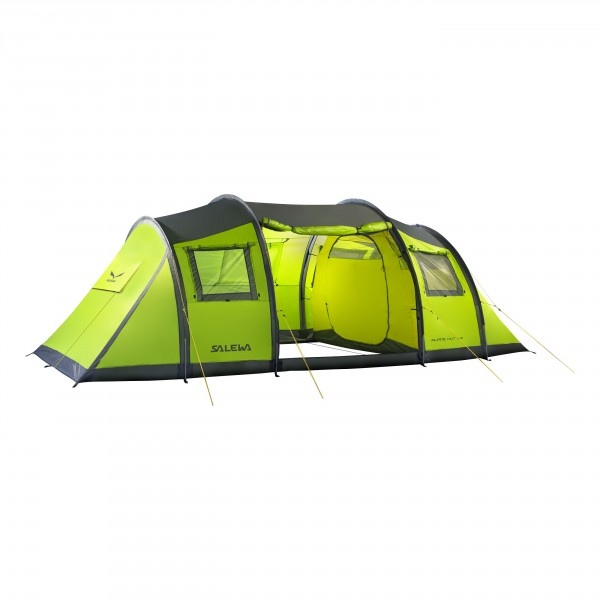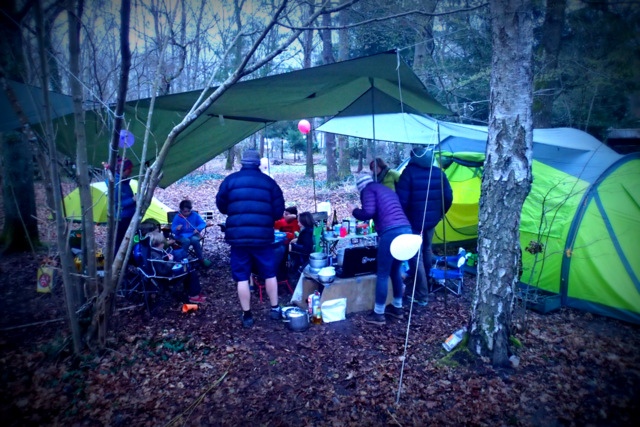Salewa Alpine Hut III + III Family Tent
12th May 2016
Our beloved Vango Equinox family tent has finally given up the ghost so we needed to replace it. Sadly Vango have discontinued the Equinox so I began to look around. An hour spent perusing the offer at a local Yeoman’s tent display last me with a very clear idea of what I was after, and what I was not, but despite there being over 100 tents on offer there, not one fitted the bill. Enter Salewa, a European brand making forays into the UK market place in partnership with Wild Country, who coincidentally have their headquarters just 5 miles down the road.
The Alpine Hut III + III is, as the name implies, designed to sleep 6, 3 in each of two identically sized compartments that sit either side of a large central porch. We are a family of 4 so it has plenty of space for us, allowing for the kids to bring along a mate or two when they feel like it without things getting cramped. It’s a classic tunnel tent, with 4 straight, aluminium poles, that are threaded through colour coded sleeves in the outer and bent over into hoop shapes to form the skeleton. Once the poles are in (warning: fitting the second end of each pole into its respective point is pretty tough and requires that there is absolutely no slack material in the sleeve) it’s a simple matter of pegging out the two corner points at each end, to ‘stand’ the tent up. Once the 4 corners are in there are ample additional pegging points around the permitter of the tent, with a decent number of guy-lines to use depending on the weather. Once the outer is firmly pitched the two inner compartments are hung from a series of plastic rings via opposing plastic toggles. The top, outermost toggle is colour coded to make sure you get them in the right sequence, but be warned that as the pods are symmetrical it is possible to put them in with the hinge (by this I mean the vertical section of the oval door that has no zip and effectively becomes the hinge on which the door opens) can be set up next to the main tent door, or next to the back wall of the porch. Our preference is to have the hinge against the back wall, so that the pods open close to the main door. The resulting construction is such that when you are inside the sleeping compartments you are separated from the world by a waterproof outer fly, and a lightweight inner, but in the porch / living compartment there is just the outer.
The tent is a fairly pleasant, if bright, lime green with a black roof and base. The black roof helps to keep out a little light in the morning, but be warned that it is pretty light inside - which we loved (better to be light for the majority of the day, and those who sleep lightly in the morning wear an eye mask, than to have a tent that’s dark all the time). It has a single large door which opens up the whole of one side of the living compartment. This door has two zips, one on each side, running top to bottom, and can thus be rolled up out of the way and tied with toggles and elastic loops. It also comes with two additional heavier duty steel poles which can be fixed to the corner points of the open door, and tensioned with additional guy lines, to make an awning out the front of the tent. This was very well used on our recent trip to the forests of Fontainebleau in France where it rained every day! My one complaint would be that there ought to be some sort of gusset in place to fill at least some of the space between the tent and the door, to stop rain coming in that triangular space when the awning is up.
The tent, if not bright enough inside thanks to the lime green material, has ample windows too. 6 to be precise, 3 down each side. The two in the porch walls are sewn in plastic with zip away shutters inside. Each sleeping compartment then has one in each side wall. As there are two layers between you and the outside world there are windows in each wall. On the outer is a mosquito (actually midge) proof square of material forming the window. As this gauze is not waterproof it’s important to keep the zippable and waterproof shutters closed in bad weather, but in good weather, the windows also act as additional ventilation. The inner wall has an equivalency positioned gauze window. The zips that close the outer shutters have a full length baffle to keep out the water, which can be firmly closed with a long Velcro strip on each. It’s very well designed. In addition to the windows that can double as vents, there are an additional two vents in each end of the tent. This are opened from the outside by unzipping the side walls of another shutter that’s hinged at the top. These vents have the gutter that I was referring to earlier meaning that water can’t be driven in at the sides. The shutter, once unzipped, is held out by guy lines. Last, but not least on the vent front is the main door, which is effectively a double skin, with a waterproof outer, and a gauze inner. The outer can be rolled up or guy’d out on the steel poles, whilst leaving the gauze inner down to protect you fro m biting insects.All in all a very well designed set of windows and vents, the only downside being that you have to get out of the tent in order to open and close most of them.

Inside each sleeping compartment are a couple of large pockets for books, torches and other bits and pieces, plus a single large pocket for the door to the pod to be stowed when open. Personally i would have liked to see some additional pockets in both the pods, and also in the living compartment which has only two small pockets near the entrance. The sleeping compartments are plenty big enough for my 6 foot 5 inch frame, plus my wife, plus a couple of bags of clothes etc. The living compartment is big enough to stand in as well as plenty big enough for a whole load of kit, including a table and chairs if you need. There’s no groundsheet in the living compartment, but the two sleeping pods are fully sealed from the outside world.
There are a couple of other features that are worth mentioning as it’s the little touches that make it stand out for me. When you pack the tent away the guy lines each have a handy small plastic toggle to allow you to coil and store them so they don’t get tangled when you are next putting it up. It also has a snow valence. On all previous tests the snow valences I have seen have been a thin skirt of material outside the main body of the tent that you can put snow, or even rocks, onto if pegging is difficult. On this tent the the strip of material is actually on the inside of the tent. We haven’t yet used it in snow, but it actually worked really well in France to keep the rain and mud and leaves out of the tent, forming a raised lip across the entrance when open which took a bit of getting used to, but was very practical in the long run. I think I prefer the internal valence as it does not collect pools of water like external ones do.

Camping in the rain in France. It kept us entirely dry in some pretty awful weather. Gussets would have been handy on the awning door though.
It feels very well made and gives the impression that it will last a long time. It weighs 14kg which is more than you’d want to carry back packing, but is surprisingly light and packed up surprisingly small, for car-boot camping (it’s packed size is 60cm by 40cm by 40cm, which can actually be compressed a fair bit). It packs away into its bag very easily, and comes with ample steel pegs. It retails at €850. A few of our fellow campers expressed surprise at this, but I argued that it is far, far, better quality than the tents at the tent display.
More information on the Salewa website
You can buy the tent in the UK at Tiso.
